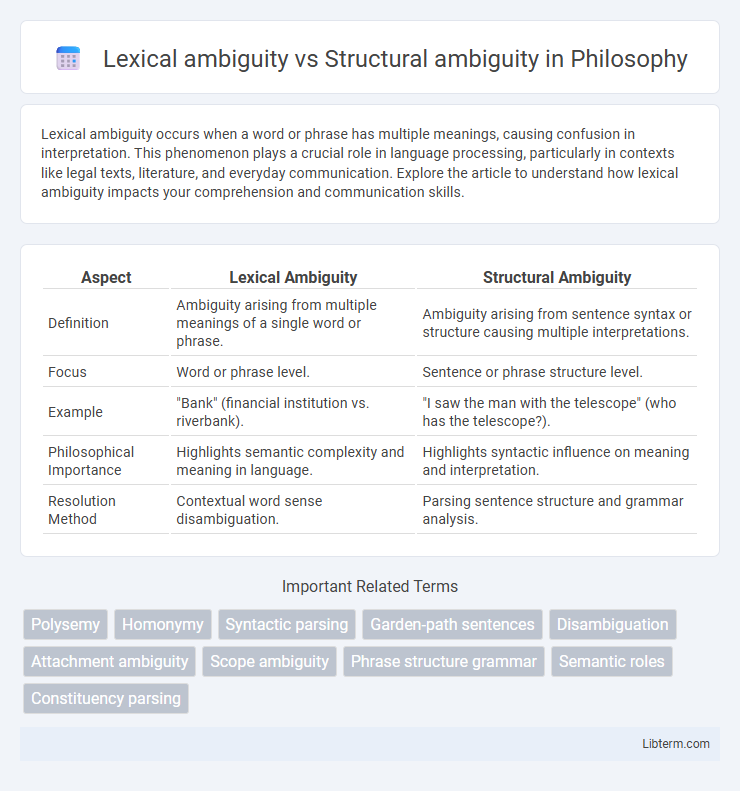Lexical ambiguity occurs when a word or phrase has multiple meanings, causing confusion in interpretation. This phenomenon plays a crucial role in language processing, particularly in contexts like legal texts, literature, and everyday communication. Explore the article to understand how lexical ambiguity impacts your comprehension and communication skills.
Table of Comparison
| Aspect | Lexical Ambiguity | Structural Ambiguity |
|---|---|---|
| Definition | Ambiguity arising from multiple meanings of a single word or phrase. | Ambiguity arising from sentence syntax or structure causing multiple interpretations. |
| Focus | Word or phrase level. | Sentence or phrase structure level. |
| Example | "Bank" (financial institution vs. riverbank). | "I saw the man with the telescope" (who has the telescope?). |
| Philosophical Importance | Highlights semantic complexity and meaning in language. | Highlights syntactic influence on meaning and interpretation. |
| Resolution Method | Contextual word sense disambiguation. | Parsing sentence structure and grammar analysis. |
Introduction to Linguistic Ambiguity
Lexical ambiguity occurs when a single word has multiple meanings, such as "bank" referring to a financial institution or a riverbank. Structural ambiguity arises from the arrangement of words in a sentence, leading to multiple interpretations, like "I saw the man with the telescope" which can mean either the observer or the man possesses the telescope. Understanding these two types of linguistic ambiguity is essential for natural language processing and effective communication.
Defining Lexical Ambiguity
Lexical ambiguity occurs when a single word has multiple meanings within a context, causing confusion about which definition applies. It contrasts with structural ambiguity, where the sentence's overall structure creates multiple interpretations. Understanding lexical ambiguity is crucial for accurate language processing and disambiguation in natural language understanding systems.
Understanding Structural Ambiguity
Structural ambiguity arises when a sentence can be interpreted in multiple ways due to its syntactic structure rather than word meaning, making it crucial to analyze sentence components like phrase attachment and clause boundaries. Understanding structural ambiguity involves recognizing how word order and punctuation influence different interpretations, such as "I saw the man with the telescope," where it's unclear whether the man or the observer has the telescope. Lexical ambiguity, in contrast, stems from a single word having multiple meanings, but structural ambiguity focuses on the arrangement of words affecting the sentence's meaning as a whole.
Key Differences Between Lexical and Structural Ambiguity
Lexical ambiguity arises when a single word has multiple meanings, while structural ambiguity occurs due to multiple possible sentence structures affecting interpretation. Lexical ambiguity hinges on word-level polysemy or homonymy, whereas structural ambiguity involves syntax-driven variations in phrase or clause attachment. Understanding these distinctions is crucial for natural language processing systems to accurately disambiguate meaning in context.
Examples of Lexical Ambiguity in Everyday Language
Lexical ambiguity occurs when a single word has multiple meanings, such as the word "bank," which can refer to a financial institution or the side of a river. This type of ambiguity is common in everyday language, exemplified by phrases like "I saw her duck," where "duck" can mean either a bird or the action of lowering the head. Understanding lexical ambiguity is crucial for effective communication and natural language processing, as context determines the intended meaning.
Illustrations of Structural Ambiguity in Sentences
Structural ambiguity arises when a sentence can be interpreted in multiple ways due to its syntax rather than the meaning of individual words. For example, the sentence "I saw the man with the telescope" can mean either that I used a telescope to see the man or that the man I saw was holding a telescope. Another example is "She watched the girl with the binoculars," which can imply either the observer used binoculars or the girl being watched had them.
Impact of Ambiguity on Communication
Lexical ambiguity occurs when a word has multiple meanings, causing misunderstandings in communication, while structural ambiguity arises from unclear sentence syntax, leading to different interpretations. Both types of ambiguity disrupt message clarity, often resulting in confusion or misinterpretation in verbal and written exchanges. Effective communication relies on minimizing these ambiguities through precise language and context awareness to ensure accurate information transfer.
Ambiguity in Linguistic Analysis and Syntax
Lexical ambiguity arises when a single word possesses multiple meanings, such as "bank" referring to a financial institution or a river's edge, posing challenges in semantic interpretation. Structural ambiguity occurs when a sentence's syntax allows for multiple legitimate parses, exemplified by "I saw the man with the telescope," where attachment ambiguity affects meaning. Analyzing these ambiguities in linguistic syntax is crucial for natural language processing and computational linguistics to enhance disambiguation algorithms and accurate semantic parsing.
Resolving Ambiguity in Natural Language Processing
Lexical ambiguity arises when a word has multiple meanings, while structural ambiguity occurs when the sentence structure allows for multiple interpretations. Resolving ambiguity in natural language processing relies on context analysis, part-of-speech tagging, and syntactic parsing algorithms to accurately determine intended meanings. Techniques like word sense disambiguation and dependency parsing enhance the precision of semantic understanding by differentiating between lexical and structural sources of ambiguity.
Conclusion: The Importance of Addressing Ambiguity
Addressing lexical and structural ambiguity is crucial for clear communication and effective language processing. Lexical ambiguity arises when a word has multiple meanings, while structural ambiguity occurs from multiple possible sentence interpretations. Clarifying these ambiguities enhances comprehension in natural language processing, translation, and everyday interactions, reducing misunderstandings and improving semantic accuracy.
Lexical ambiguity Infographic

 libterm.com
libterm.com